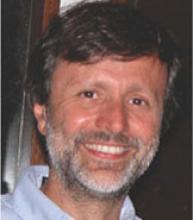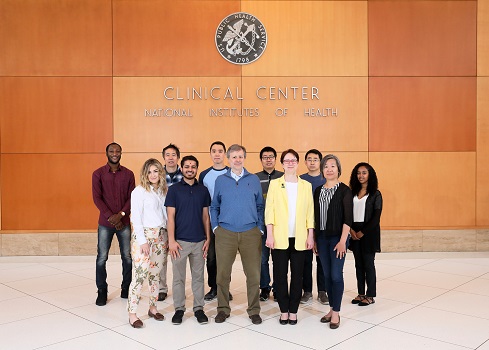Viral Pathogenesis Section
Paolo Lusso, M.D., Ph.D.
Chief, Viral Pathogenesis Section

Major Areas of Research
- Novel approaches (including mRNA) to the development of an HIV-1 vaccine
- Structure-function relationships in the HIV-1 envelope
- Structure-based design of improved therapeutic monoclonal antibodies
- Molecular basis of HIV-1 immune evasion
- Role of chemokines and other endogenous immune modulators in HIV-1 disease
Program Description
Despite the extraordinary advances in HIV research over the past 30 years, the AIDS pandemic remains one of the greatest scientific challenges in the world. The main focus of the Viral Pathogenesis Section (VPS) is to study the pathogenesis of HIV/AIDS and devise innovative strategies for therapy and vaccine. A primary area of interest is the elucidation of the structure-function relationships within the HIV-1 envelope, with the aim of identifying conserved functional regions and elucidating the structural basis of immune evasion, one of the main obstacles to vaccine development. This knowledge guides the VPS efforts to rationally engineer improved neutralizing antibodies and new vaccine immunogens capable of eliciting protective immune responses.
Other research topics include the study of endogenous immune modulators that regulate HIV-1 transmission, replication, and pathogenesis, including antivira chemokines, integrin α4β7 and interleukin-7. The VPS uses a comprehensive research approach that combines classic immunology and virology with state-of-the-art post-genomic technologies and pre-clinical in vivo studies in nonhuman primates.
Biography
Education
PH.D., Ministry of Scientific and Technologic Research, Rome, Italy
M.D., University of Turin, Turin, Italy
Dr. Lusso received his M.D., summa cum laude, from the University of Turin and his Ph.D. from the Ministry of Scientific and Technologic Research, Rome, Italy. He is a board-certified specialist in internal medicine and in infectious diseases. He came to NIH for the first time in 1986 to work in the Laboratory of Tumor Cell Biology under Dr. Robert C. Gallo at the National Cancer Institute. He returned to Italy in 1994, where he created the Laboratory of Human Virology at the San Raffaele Scientific Institute in Milan and became associate professor of infectious diseases at the University of Cagliari. In 2006, he again joined NIH, where he became chief of the Viral Pathogenesis Section in the Laboratory of Immunoregulation. He is an executive editor of Current HIV Research and a member of the editorial board of several other journals. He is an elected member or the European Molecular Biology Organization (EMBO) and a Fellow of the American Academy of Microbiology (AAM).
Selected Publications
Zhang P, Narayanan E, Liu Q, Tsybovsky Y, Boswell K, Ding S, Hu Z, Follmann D, Lin Y, Miao H, Schmeisser H, Rogers D, Falcone S, Elbashir SM, Presnyak V, Bahl K, Prabhakaran M, Chen X, Sarfo EK, Ambrozak DR, Gautam R, Martin MA, Swerczek J, Herbert R, Weiss D, Misamore J, Ciaramella G, Himansu S, Stewart-Jones G, McDermott A, Koup RA, Mascola JR, Finzi A, Carfi A, Fauci AS, Lusso P. A multiclade env-gag VLP mRNA vaccine elicits tier-2 HIV-1-neutralizing antibodies and reduces the risk of heterologous SHIV infection in macaques. Nat Med. 2021 Dec;27(12):2234-2245.
Liu Q, Lai YT, Zhang P, Louder MK, Pegu A, Rawi R, Asokan M, Chen X, Shen CH, Chuang GY, Yang ES, Miao H, Wang Y, Fauci AS, Kwong PD, Mascola JR, Lusso P. Improvement of antibody functionality by structure-guided paratope engraftment. Nat Commun. 2019 Feb 13;10(1):721.
Zhang P, Gorman J, Geng H, Liu Q, Lin Y, Tsybovsky Y, Go EP, Dey B, Andine T, Kwon A, Patel M, Gururani D, Uddin F, Guzzo C, Cimbro R, Miao H, McKee K, Chuang GY, Martin L, Sironi F, Malnati MS, Desaire H, Berger EA, Mascola JR, Dolan MA, Kwong PD, Lusso P. Interdomain stabilization impairs CD4 binding and improves immunogenicity of the HIV-1 envelope trimer. Cell Host Microbe. 2018 Jun 13;23(6):832-844.e6. d
Guzzo C, Ichikawa D, Park C, Phillips D, Liu Q, Zhang P, Kwon A, Miao H, Lu J, Rehm C, Arthos J, Cicala C, Cohen MS, Fauci AS, Kehrl JH, Lusso P. Virion incorporation of integrin α4β7 facilitates HIV-1 infection and intestinal homing. Sci Immunol.2017 May 12;2(11).
Liu Q, Acharya P, Dolan MA, Zhang P, Guzzo C, Lu J, Kwon A, Gururani D, Miao H, Bylund T, Chuang GY, Druz A, Zhou T, Rice WJ, Wigge C, Carragher B, Potter CS, Kwong PD, Lusso P. Quaternary contact in the initial interaction of CD4 with the HIV-1 envelope trimer.Nat Struct Mol Biol. 2017 Apr;24(4):370-378.
Cocchi F, DeVico AL, Garzino-Demo A, Arya SK, Gallo RC, Lusso P. Identification of RANTES, MIP-1 alpha, and MIP-1 beta as the major HIV-suppressive factors produced by CD8+ T cells. Science. 1995 Dec 15;270(5243):1811-5.
Research Group
HIV/AIDS pathogenesis & strategies for therapy & vaccine. Structure-function relationships in envelope glycoproteins can identify conserved functional regions & elucidate immune evasion, supporting VPS efforts to engineer HIV-neutralizing antibodies with improved potency & breadth. We combine immunology & virology with post-genomic technologies & pre-clinical in vivo studies in nonhuman primates.


